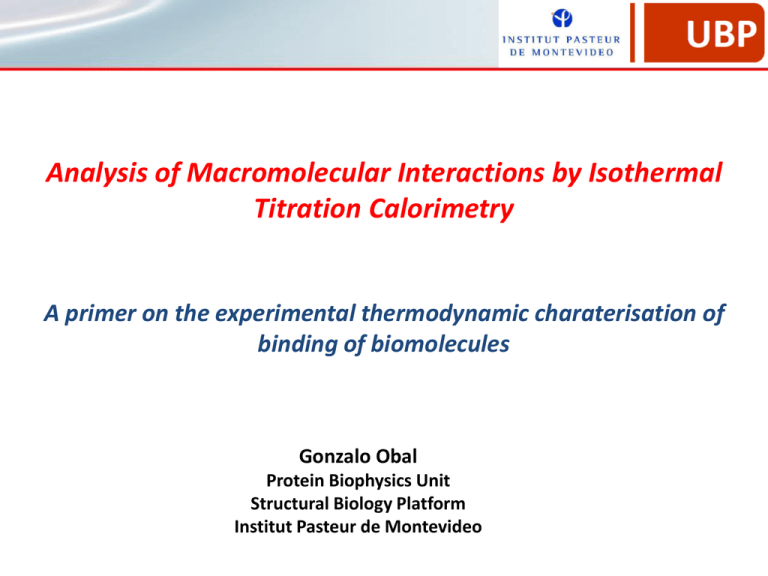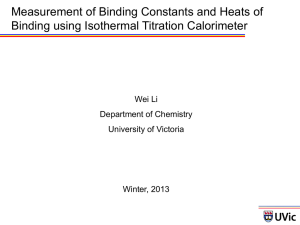Protein
advertisement

Analysis of Macromolecular Interactions by Isothermal Titration Calorimetry A primer on the experimental thermodynamic charaterisation of binding of biomolecules Gonzalo Obal Protein Biophysics Unit Structural Biology Platform Institut Pasteur de Montevideo Biomolecular interactions: why are they important? Corpora non agunt nisi ligata Paul Ehrlich All (or almost all) biological phenomena depends on interactions between molecules Antibody-antigen / Enzyme-sustrate / Receptor-hormone / Signaling cascades Protein-lipid / Protein-carbohydrate / Protein-peptide / Protein-DNA Protein-RNA / ADN-ARN /…etc, etc,etc….. Binding of macromolecules is the basis of discrimination between partners and non-partners molecular especificity So, without binding there is no biology (ie Protein-protein interaction network map in yeast. Shown are the 2358 known interactions for the 1548 proteins actually available in the yeast proteome. Color correlates with function: membrane fusion (blue), cromatin structure (grey), celular structure (green), lipid metabolism (yellow), cytoquinesis (red).Schwikowski, Uetz & Fields (2000) A network of interacting proteins in yeast. Nat. Biotechnol. 18, 1257–1261 A remarkable example: metal sensing E.coli a. The volume of an E. coli cell is about 1.8E-15 L... …thus, the lowest intracelular Zn2+ croncentration is about 1E-9M (i.e. 1 ion Zn2+ per bacteria!). b. Zn2+ sensor in E. coli manage uptake/expulsion of ions, being sensible to concentration below 10E-15M … …thus, in tipical conditions, intracelular concentration of Zn2+ should be of less than 1 átomo Zn2+/E. coli Femtomolar Sensitivity of Metalloregulatory Proteins Controlling Zinc Homeostasis Outten & O’Halloran (2001) Science 292, 5526 Thus...a complete interpretation of any interaction under a particular biological scenario requires the knowledge of both the strength of binding and concentration of the molecules involved So, consider it when studying binding: -The biological relevance of Kd depens on the actual concentrations of interacting partners -Free protein and ligand concentrations will dictate the extent of binding, via Kd -Thermodynamic and kinetic control of reactions exists…..´´even´´ in biology The goals of binding studies are to aswer the questions: HOW MANY? WHERE? HOW TIGHTLY? WHY? HOW FAST? HOW? Binding studies should ultimately elucidate each question in order to provide a complete understanding of a biomolecular interaction…… (this is a long, complex, interdisciplinary task) What information do we need to get a full characterisation of an interaction? (from a biophysical point of view) THERMODYNAMICS Stoichimetry Affinity (strength) other thermodynamic properties (H, S, Cp) KINETICS rate constants for association (kon) and disociation (koff) Reaction mechanism STRUCTURE Three-dimensional structure of partners and their complex(es) DYNAMICS the Molecular dynamics of individual interacting their complex(es) individual interacting partners and How to analyse protein-ligand interations? There´s a wide toolkit of methods (with both advantages and pitfalls).. … qualitative methodologies (yes/no information)… • Double-hybrid • Pull-down method (TAP, co-precipitation) in vivo e in vitro • protein arrays …and quantitatives • • • • • • • • • • • • • Equilibrium dialysis EMSA / native PAGE / Blue Native Page ELISA / RIA Fluorescence (FRET, quenching, anisotropy) Light scattering Surface plasmon resonance Surface wave resonance Asymmetric flow-filled fractionation Stopped-flow (coupled to a wide option of detectors) ITC NMR AUC QCM (quartz crystal microbalance/piezoelectric acoustic sensor The basics of binding interactions Definition of binding affinity for macromolecular recognition The binding of two (any number) of proteins can be viewed as a reversible process, in an equilibrium governed by the law of mass action The (very) basics of binding interactions Definition of binding affinity for macromolecular recognition General properties of binding isotherms: Fractional Saturation Y = [X]/([X]+Kd) For X = 0 Y=0 nothing bound For X Y=1 full occupancy For X = KD Y = 0.5 half occupancy Thermodynamic properties of a binding reaction Binding constants provide an entry into thermodynamics…and viceversa Thermodynamic properties of a binding reaction Binding constants provide an entry into thermodynamics…and viceversa -To analyse a binding reaction we need somehow to ´´see´´ how substrates are being consumed and/or products are being formed -So, we´ll follow the extent of the reaction KA MX / M X 1/KD Complex formed unbound macromolecule unbound ligand Basically, the idea of every binding experiment involves fixing the concentration of one of the interactors (tipically M) and varying the one of the other, having found some ´´signal´´ that changes proportionally to the amount of complex formed. ...so we need some signal for monitoring a binding reaction (i.e. follow/determine Y) … -direct measurement of the concentration of one interactor -fluorescence (intrinsic/extrinsic -anisotropy -FRET -heat -……… … ¿which one and how do we use it? Two general methods for determining binding constants: 1) Measure bound vs. Free ligand/protein at equilibium as a function of concentration 2) Measure association and dissociation rate constants and use these to calculate binding constants How do we calculate affinity from a titration experiment? First: where: Total macromolecule and ligand concentration are: MX,M, y X are the concentrations for free complex, macromolecule, and ligand So we write Kd as: Rearranging terms: As: We re-write: O en su forma mas común: so…we ``follow´´ a signal proportional to the amount of complex formed as a function of x WORKFLOW OF QUANTITATIVE CHARACTERISATION OF BIOMOLECULAR BINDING INTERACTIONS PRODUCTION OF REACTANTS CHARACTERISATION OF REACTANTS IMPROVED EXPERIMENTAL DESIGN SIMULATION SELECTION OF METHOD(S) BINDING EXPERIMENT INTERPRETATION Equilibrium MODEL SELECTION and/or CONSTRUCTION RESULTS DATA ANALYSIS (FITTING & STATISTICS) BINDING EQUATIONS (BIOLOGICAL SIGNIFICANCE) Isothermal Titration Calorimetry Overview and Applications Theory and Instrumentation Experimental setup Concepts of ITC data analysis Examples: interpreting ITC results in context of structural thermodynamics Isothermal Titration Calorimetry • ITC measures the heat uptake or release during a biomolecular reaction – Heat is taken up (absorbed, endothemic) – Heat is evolved (released, exthermic) • Calorimetry is the only method that can directly measure the binding energetics of biological processes Microcalorimetry provides binding stoichiometry • Number of ligand binding sites per macromolecule – on a molar basis, modelindependent (by convention a ´´Ligand´´ has one binding site, and a ´´Macromolecule´´ can have more than one) Microcalorimetry is a gold-standard for binding analysis • • • • • Label-free In-solution No MW limitations Optical transparency/clarity unimportant Minimal assay development Microcalorimetry is (almost) universally applicable to study interactions between: • • • • • • • • • Protein-small molecule Enzyme-inhibitor Protein-protein Protein-DNA Protein-RNA Protein-lipid/liposomes Protein-carbohydrate Other non-biological binding reactions Oligomerisation Microcalorimetry provides a total picture of binding energetics (however, it is not easy to relate physicochemical properties (G, H, S) specifically and directly to binding mechanisms) Very broadly: i) H reflects energy changes associated with making (-H) and breaking (+ H) of bonds (hidrogen , van der Walls bonding, solvent) Entalphy-driven reactions (high affinity) ii) S reflects changes associated with increasing (+ S) or decreasing (- S) the number of microscopic configurations (hydrophobic interactions, flexibility, solvent) Entropy-driven reactions (high specificity) Importantly, the relative contribution of H and S to G govern/distinguish the functional characteristics of R-L interactions This is a major concern in drug discovery and agonist/antagonist mechanism ITC: instrumental concepts The idea is to titrate a macromolecule (in the cell) by serially injecting a ligand (in the syringe), while recording the evolved (absorved/release) heat Sample Cell Reference Cell T = 0 Ligand X in syringe Receptor M in cell VP-ITC (GE, Microcal) at UBP-BS/IPMON Step by step… …¿how do we get information from an ITC experiment? 1.- titration: First, we perform ´´data collection: power (cal o J/seg) as a function of time (s) Every binding event (injection) is associated to a given amount of heat released (exothermic) or absorved (endothermic) P = dQ/dt …recapitulating, the concept is: 1) In each injection we add n moles of X to a fixed amount of M (MT), releasing or absorving some heat qi 2) Thus… at every XT /MT, we directly measure its associated qi… Finally… (Wiseman Isotherm) …given qi for every injection we have: n 1 qi = Qreacción 1 …experiment is done a constant T and P, thus: 2 Qreacción = H (Ajuste a modelo n sitios de unión) 3 4 The shape of binding isotherms depends of the vallue of KD (this is important from a practical consideration, as this limits the conditions of the experiment) Data analysis i) Global ITC data analysis Global fitting routines to different binding models Situation could complicate for n2 Cooperativity is sometimes difficult to analyse (specially negative coopeative) ii) Optimisation and Statistical error analysis Monte Carlo simulations of binding data Variance-Covariance Matricial analysis of statistical significance iii) Global Multimethod Analysis (GMMA) Sometimes ITC (or any other technique) data are not sufficient for obtaning a plausible explanation Combination of other methodologies are required (orthogonal information) Other complication: proteins (biomolecules) are dynamics (native ensemble) Other complication: proteins (biomolecules) are dynamics (native ensemble) Induced fit Conformational selection Conformational selection + Induced fit cAMP binding to catabolite inhibitory protein CAP CAP is an homodimeric protein what does the ITC shows? Suggests two sites (independent? sequential?) …where binding of a second cAMP molecules is entropically disfavourable How can we explain negative cooperativity from the thermodynamic properties of? Check for entropy change (conformational) of the protein during cAMP binding… S S Thus, a thermodynamic model can be propose: No cAMP: Both monomers are flexible Affinity fo cAMP is identical at both sites Binding of 1 cAMP: Bound monomer rigidifies Binding of 2 AMP: All potein rigidifies Thanks! Questions?





